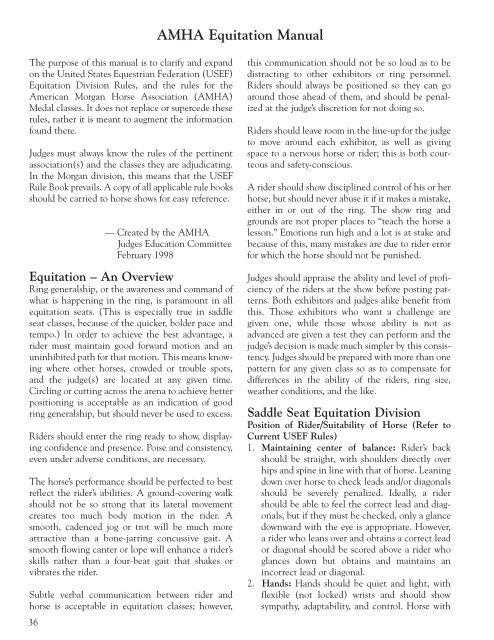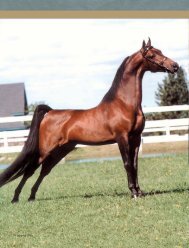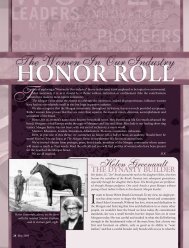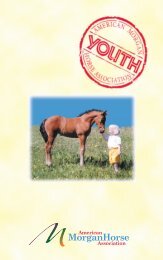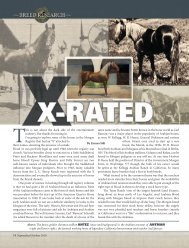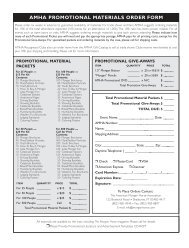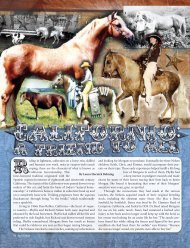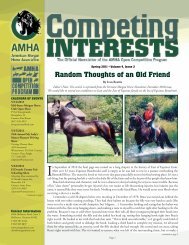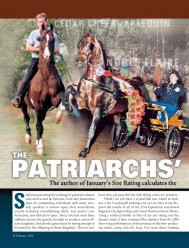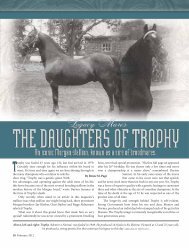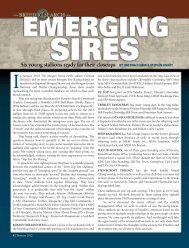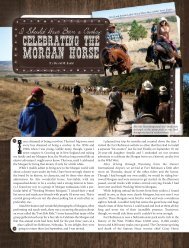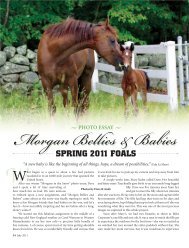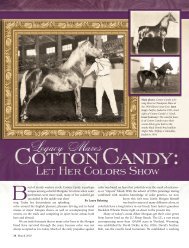Judging School Handbook - American Morgan Horse Association
Judging School Handbook - American Morgan Horse Association
Judging School Handbook - American Morgan Horse Association
You also want an ePaper? Increase the reach of your titles
YUMPU automatically turns print PDFs into web optimized ePapers that Google loves.
AMHA Equitation ManualThe purpose of this manual is to clarify and expandon the United States Equestrian Federation (USEF)Equitation Division Rules, and the rules for the<strong>American</strong> <strong>Morgan</strong> <strong>Horse</strong> <strong>Association</strong> (AMHA)Medal classes. It does not replace or supercede theserules, rather it is meant to augment the informationfound there.Judges must always know the rules of the pertinentassociation(s) and the classes they are adjudicating.In the <strong>Morgan</strong> division, this means that the USEFRule Book prevails. A copy of all applicable rule booksshould be carried to horse shows for easy reference.36— Created by the AMHAJudges Education CommitteeFebruary 1998Equitation – An OverviewRing generalship, or the awareness and command ofwhat is happening in the ring, is paramount in allequitation seats. (This is especially true in saddleseat classes, because of the quicker, bolder pace andtempo.) In order to achieve the best advantage, arider must maintain good forward motion and anuninhibited path for that motion. This means knowingwhere other horses, crowded or trouble spots,and the judge(s) are located at any given time.Circling or cutting across the arena to achieve betterpositioning is acceptable as an indication of goodring generalship, but should never be used to excess.Riders should enter the ring ready to show, displayingconfidence and presence. Poise and consistency,even under adverse conditions, are necessary.The horse’s performance should be perfected to bestreflect the rider’s abilities. A ground-covering walkshould not be so strong that its lateral movementcreates too much body motion in the rider. Asmooth, cadenced jog or trot will be much moreattractive than a bone-jarring concussive gait. Asmooth flowing canter or lope will enhance a rider’sskills rather than a four-beat gait that shakes orvibrates the rider.Subtle verbal communication between rider andhorse is acceptable in equitation classes; however,this communication should not be so loud as to bedistracting to other exhibitors or ring personnel.Riders should always be positioned so they can goaround those ahead of them, and should be penalizedat the judge’s discretion for not doing so.Riders should leave room in the line-up for the judgeto move around each exhibitor, as well as givingspace to a nervous horse or rider; this is both courteousand safety-conscious.A rider should show disciplined control of his or herhorse, but should never abuse it if it makes a mistake,either in or out of the ring. The show ring andgrounds are not proper places to “teach the horse alesson.” Emotions run high and a lot is at stake andbecause of this, many mistakes are due to rider errorfor which the horse should not be punished.Judges should appraise the ability and level of proficiencyof the riders at the show before posting patterns.Both exhibitors and judges alike benefit fromthis. Those exhibitors who want a challenge aregiven one, while those whose ability is not asadvanced are given a test they can perform and thejudge’s decision is made much simpler by this consistency.Judges should be prepared with more than onepattern for any given class so as to compensate fordifferences in the ability of the riders, ring size,weather conditions, and the like.Saddle Seat Equitation DivisionPosition of Rider/Suitability of <strong>Horse</strong> (Refer toCurrent USEF Rules)1. Maintaining center of balance: Rider’s backshould be straight, with shoulders directly overhips and spine in line with that of horse. Leaningdown over horse to check leads and/or diagonalsshould be severely penalized. Ideally, a ridershould be able to feel the correct lead and diagonals,but if they must be checked, only a glancedownward with the eye is appropriate. However,a rider who leans over and obtains a correct leador diagonal should be scored above a rider whoglances down but obtains and maintains anincorrect lead or diagonal.2. Hands: Hands should be quiet and light, withflexible (not locked) wrists and should showsympathy, adaptability, and control. <strong>Horse</strong> with


